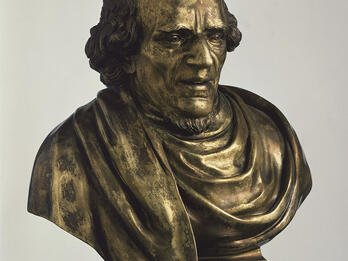Words of Peace and Truth
Naphtali Herts Wessely
1782
There is one people in the world alone who are not sufficiently concerned with “human knowledge” and who have neglected the public instruction of their youth in the laws of etiquette, the sciences and the arts. We, the children of Israel, who are dispersed throughout all of Europe and who live in most of its states, have turned our backs on these…
Creator Bio
Naphtali Herts Wessely
Born in Hamburg and raised in Copenhagen, Naphtali Herts Wessely was a pioneering Haskalah figure and a contemporary of Moses Mendelssohn. He studied religious subjects under Jonathan Eybeschütz, but also studied modern languages and eventually became a poet and linguist, exploring biblical Hebrew and writing biblical commentaries. Wessely urged a complete change of attitude toward non-Jews. He was a practicing Jew whose significance lay in his call to reimagine Ashkenazi Jewish society and culture from the top down. His epistle was a gauntlet thrown down to traditional rabbinic authority and was widely seen as the text that crystallized the aims of the Haskalah (Jewish Enlightenment) movement. As a representative of the Feitel Bank, Wessely moved to Berlin, where he met Mendelssohn. He strongly advocated for the social and educational reforms laid out in Joseph II of Austria’s Edict of Toleration, writing Divre shalom ve-emet (1782) to advocate for Jews in German-speaking lands to accept these reforms.
Related Guide
Intellectual and Religious Thought
The Jewish encounter with modernity from 1750 to 1880 engendered a deeply ideological age. Advocates of enlightenment, of liberalism, of revolution against old regimes fought bitter polemics with forces seeking stasis, stability, tradition, and the familiar strata of privilege.
Related Guide
Haskalah and Pedagogy
The first maskilim ransacked both Jewish and European tradition to find new platforms for creating and transmitting the Jewish cultural ideals they conceived. Jews enlisted diverse literary genres to call for social, educational, and economic change.
You may also like
Introduction to Euclid
Light for the Path

Letter to the Friends of Lessing (On the Spinoza Conversations between Lessing and Jacobi)



